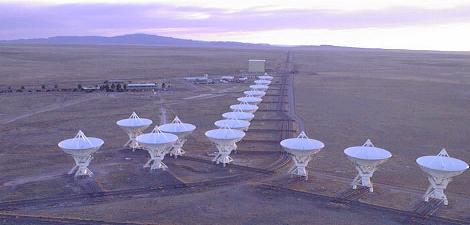Back to VLA Science Highlights



The National Science Foundation's Very Large Array is a radio telescope using 27 antennas arranged in a ``Y'' shape on the Plains of San Agustin 50 miles west of Socorro, NM. All 27 antennas usually work together as a single instrument. Each antenna uses a parabolic dish 25 meters (82 feet) in diameter, and weighs 230 tons. The antennas are placed in four standard configurations, with the maximum separation ranging from 1 km to 36 km. The configuration is changed approximately once every four months by using special transporter vehicles to move the antennas along dual sets of of railroad tracks and place them on concrete pads distributed along the arms of the ``Y''. The VLA is used to produce images of the sky as seen at radio wavelengths. Both the pointing and the data collection of the antennas are controlled by computers in real time. Initial processing of the collected data is done in real time on-site, with calibration, post-processing and image production later, either at VLA facilities or at the astronomer's home institution. The VLA is one instrument of the National Radio Astronomy Observatory (NRAO). The NRAO is a facility of the National Science Foundation, operated under cooperative agreement by Associated Universities, Inc.
Radio astronomy depends upon receiving extremely weak signals from celestial objects. The signals detected by the VLA and other radio telescopes are millions or even billions of times weaker than those used for communication systems. For example, a tiny, 100-milliwatt transmitter using an omnidirectional antenna (similar to those used to control toy cars) placed on the moon would produce a signal on Earth that would be considered quite strong by radio astronomers.
The VLA can receive celestial radio waves in one of eight different frequency bands (1 MHz is one million cycles per second): 1) 72-74 MHz, 2) 300-340 MHz, 3) 1270-1730 MHz, 4) 4300-5100 MHz, 5) 7600-9000 MHz, 6)14300-15700 MHz, 7) 21700-24500 MHz, and 8) 40000-50000 MHz. The VLA receiving system can switch among these frequency bands in a time of about 20 seconds, thus making it a very powerful instrument for observing a given celestial source at many different frequencies nearly simultaneously.
The VLA's resolution varies with the array's configuration and with the frequency being observed. The larger configurations provide greater resolution than the smaller ones and the higher frequencies (shorter wavelengths) provide greater resolution than the lower frequencies. Depending on frequency, each antenna's beam ranges from 10 degrees of arc to 1 minute of arc. The width of the synthesized beam using the entire array ranges from 25 seconds of arc to 0.04 second of arc.
The VLA was formally dedicated in October of 1980, and all details of the construction were completed in January of 1981, nearly a year ahead of schedule and at the budgeted cost of $78.6 million in 1972 dollars.
